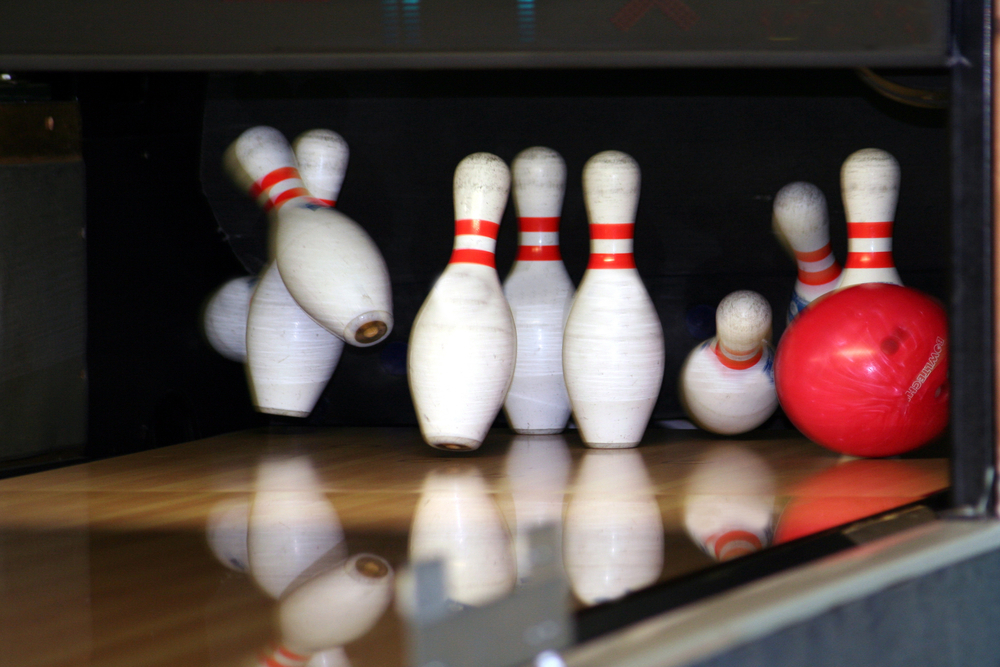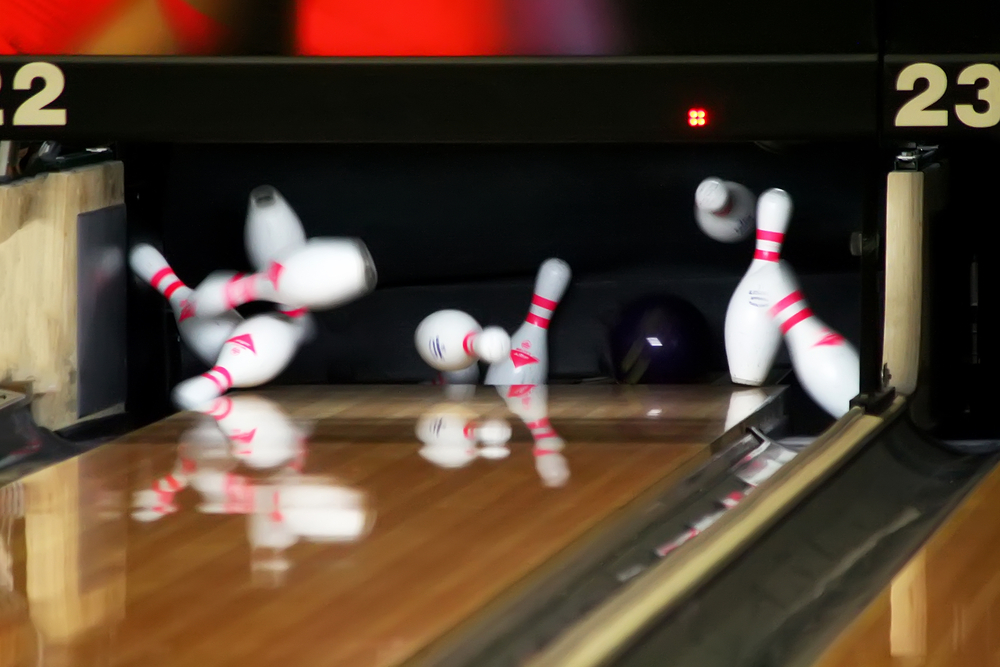
Beginners often have a hard time getting strikes. And if you've just started playing the game, we're sure you're aware of that fact from firsthand experience.
So, what is the highest score in bowling without a strike? If you're curious about how well you could do if you don't bowl a strike, this article is for you! In it, we'll tell you the highest score you can get without a strike.
Let's get right into it!
Contents
What's the Highest Score in Bowling Without a Strike
If you don't get any strikes, the next best shot in bowling is a spare; if you get all spares, the maximum score you can get is 190.
What’s the Highest Score in Bowling?
If you want to compare an all-spare game to a perfect game where you roll all strikes, there'll be a huge difference.
In a perfect game of bowling, you'll get 300 points. Being that a perfect game (without strikes) earns you 190 points, the difference is 110 points.
Can You Bowl a 300 With a Spare?
The only way to bowl a 300 is to get a strike every time. There's no other way to get that score. If you get a spare at any point in the game, your score will fall below 300.
Should You Go for a Perfect Game?
As you might imagine, bowling a perfect bowling score is 300. That is exceedingly rare. This means your first ball for every frame is a strike, including the three rolls in the tenth frame. That's twelve consecutive strikes.
Rolling a perfect score as a beginner bowler is a rare occasion.
In fact, only a handful of people have ever done it. But that doesn't mean that you can't do it! Just know that, as a beginner, your chances of rolling a perfect game are meager.
Though that's the case, it's not unheard of for people to progress quickly within the sport when they work hard at it.
What’s a Good Bowling Score for Beginners?
Now, let's examine what a good bowling score would look like for beginners. The average adult beginner scores anywhere between 50 and 70 points per game.
Some may score less than this, while others may score higher.
This is good because your score is based on the number of pins knocked down - and it means you're hitting some pins most of the time. It also means you're avoiding the gutter some of the time.
And that's all you can really ask for when you're not fully acclimated to the sport.
This estimation does not include small children. They may score lower than this due to their still-developing muscle tone and dexterity.
But if you're an adult who’s new to bowling, you may consistently roll less than 100. And that's okay! You've got a lot to learn, and there's a lot of room for improvement.

What’s a Good Bowling Score for Professional Bowlers?
On the other hand, a good bowling score for professional bowlers is around 200 points per game. We’ve come to expect higher scores like these from seasoned bowlers because they have the experience to hit most of the pins consistently.
To a professional bowler, getting a strike in a single game is not a victory - they expect to get multiple strikes per game and often get a few consecutively.
And when they don't bowl strikes, they pick up spares. This is what gets professional bowlers higher scores.
When you're a beginner, you shouldn't compare your scores to those of professionals. Doing so can cause unneeded stress and sometimes stifle your progress.
You should compare your scores to other beginners - that's much fairer. Think about it - the more stressed you are, the less control you'll have over how you throw the ball, and the more likely you will miss your target.
Tips to Improve Your Bowling Score
Want to know how to improve your bowling score? Getting a lot of practice is crucial to developing your bowling skills to score better.
However, that's not nearly the extent of it. There are many things you can do to score like a pro, and we'll get into them below.
Get Fit
You might not think being physically fit has anything to do with bowling, but it does. When you're in good shape, you have more stamina and muscle control.
This allows you to bowl for long periods of time without tiring and make precise movements when you throw the ball. Of course, you don't need to be a world-class athlete to bowl well.
Just being in decent shape will suffice.
You can get there by doing light cardio exercise a few times per week and stretching regularly. If you want to bowl even better, consider taking up strength training to help build the muscles you need to throw the ball with more power.
Choose the Right Ball
If you're using a ball that's too heavy for you, it will be difficult to control. Conversely, if you're using a ball that's too light, you won't be able to bowl with much power.
So, it's essential that you choose a ball that's the right weight for you.
The best way to find a ball that's the right weight is to go to a bowling alley and try out different ones. Start with a ball that feels good in your hand - not too heavy and not too light.
Then, see how well you can control it when you bowl.
If you can't control it well, try a slightly lighter ball. If you can control it but feel like you don't have much power behind your throws, go for a ball that's a bit heavier.
Remember, you can always ask a staff member at the bowling alley for help choosing a ball. It’s their job to ensure that you have the best bowling experience possible – they shouldn’t mind helping you out.
Find Your Stance
Your stance is critical in bowling because it affects your ability to control the ball and hit your target. If you're not comfortable with your posture, you probably won't be able to bowl very well.
The first thing you need to do is find a comfortable starting position.
Place your feet shoulder-width apart and keep your knees slightly bent. Then, raise your dominant arm and hold the ball in front of you. Experiment with different positions until you find one that feels comfortable.
The more comfortable you are with your stance, the more relaxed you’ll be as you play.
Release the Ball Correctly
If you don't release the ball correctly, it will probably end up in the gutter. So, it's vital that you learn how to do it properly.
When you're ready to bowl, raise your arm and swing the ball backward. As you swing it backward, rotate your hand, so your palm faces up.
Then, at the top of your swing, release the ball. Keep your wrist straight and aim for that middle pin in the front. Don't break your follow-through even after you feel the ball leaving your hand.
If you follow these steps correctly, you should be able to release the ball properly and avoid the gutter most of the time.
What Is the Highest Score You Can Get in Bowling With No Strikes?
The highest score you can achieve in a game of bowling without rolling any strikes is 190. This is accomplished by bowling a spare in every frame, meaning you knock down all ten pins with your two rolls in each of the ten frames.
Why Is 292 the Rarest Score?
A 292 is considered one of the rarest scores in bowling because it requires a particular sequence of rolls. The bowler must roll 11 consecutive strikes and then score a 2 on their final roll. Achieving this precise combination of strikes and then such a low score on the final roll is statistically unlikely, making a 292 game an unusual occurrence.
Can You Bowl a 300 Without All Strikes?
No, it's impossible to bowl a 300 without rolling all strikes. A perfect game of 300 points can only be achieved by rolling a strike in each of the ten frames, including the three rolls in the tenth frame, totaling twelve consecutive strikes.
What's Your Score if You Bowl All Spares?
If you bowl a spare in every frame, your final score would be 190. This scenario implies that you knocked down all ten pins with your two rolls in each of the ten frames of the game.
Related Articles
- How to Get Better at Bowling
- What Is a Good Bowling Average
- Average Bowling Score
- Highest Bowling Score
Note: There are no guarantees when it comes to bowling. Even if you feel like your ball, stance, and release are appropriate, incredibly small variations in movement can lead to a gutter ball.
So, don’t be discouraged if you try these tips and aren’t successful at first.
Keep at it, and you’ll see results before long. Now you know more about bowling scores, average scores for beginners and professionals, and more.
With the tips and information above, you're now in a better position to reach your scoring goals. We hope you found this article helpful and that you'll reference this article now and again to refine your bowling skills. We wish you the best of luck!
Kira Byrd, a Certified Fraud Examiner, holds a B.S. in Accounting from the University of Alabama at Birmingham. With a passion for bowling from her childhood, Kira has poured her expertise and personal experiences into creating and nurturing Bowling For Beginners. Kira's mission is to meet new bowlers where they are and guide them toward consistently achieving higher scores. With a focus on skill development and strategic techniques, she empowers readers to take control of their game and unlock their true potential.
Bowling For Beginners embodies strict editorial integrity, ensuring reliable and unbiased information. Kira's commitment to delivering valuable insights and practical strategies is reflected in every article. Here's an explanation of our editorial policy and how we get money.





